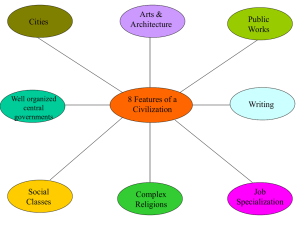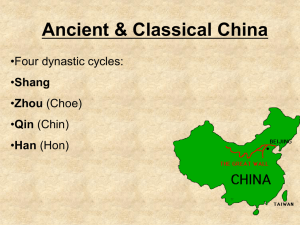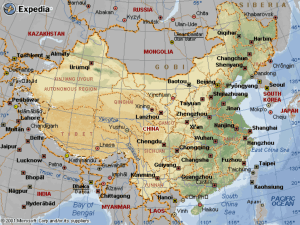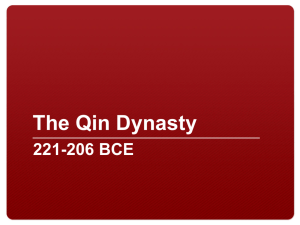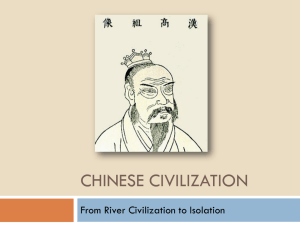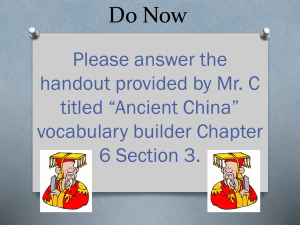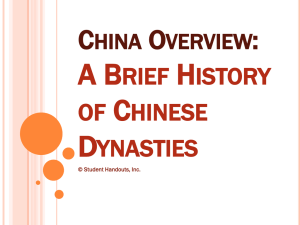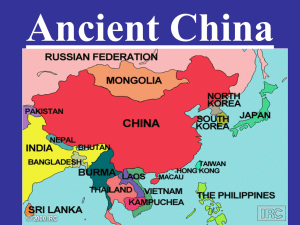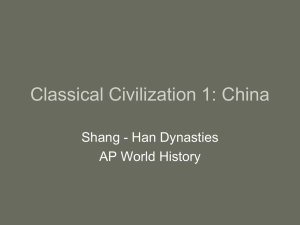China Dynasties Cornell Notes 2013
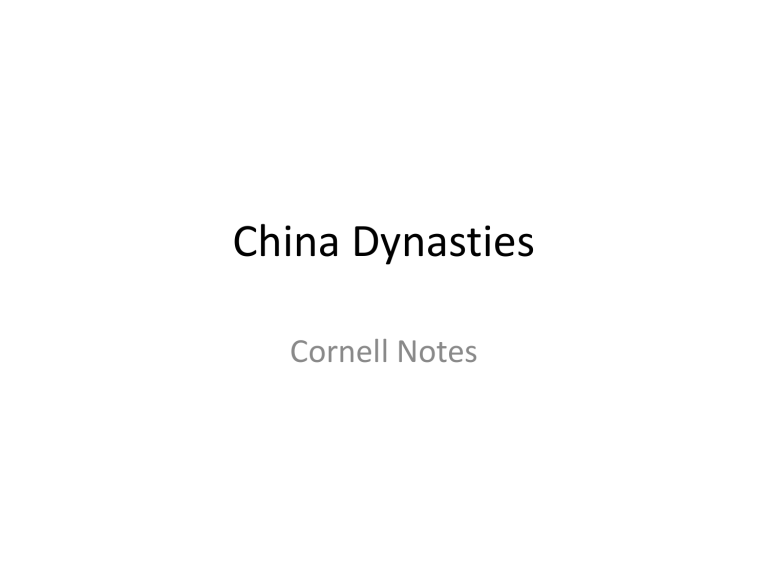
China Dynasties
Cornell Notes
Xia Dynasty
• A dynasty is a line of rulers who belong to the same family and pass control from one generation to the next.
Legend says that the “ Great
Engineer ” Yu founded the first dynasty, the Xia (shee-uh) Dynasty.
Shang/Chou Dynasties
Shang Dynasty
Chou (Zhou) Dynasty
1700 –c. 250 BCE
• Two families ruled China for the next 1500 years: first the Shang family ruled, and then the Chou family ruled.
• Important contributions of the Shang Dynasty : the use of bronze, a system of writing, ancestor worship, and the invention of chopsticks.
• Important contributions of the Chou Dynasty : the introductions of Confucianism and Taoism.
Qin Dynasty
Qin (Ch ’ in) Dynasty
Emperor: First Emperor Qin
221–206 BCE
• Although he ruled for only 15 years, First Emperor Qin accomplished great things. He ruled with absolute control and by extreme punishment.
Important contributions of the
Qin Dynasty
• First dynasty to rule/create “ China ”
• First Emperor of China-Shi Huangdi
– United China together
• Strong central government
– Start of bureaucracy
• Military expansion
– Starts the construction of the Great Wall
The Great Wall
• The Great Wall is truly big. Different parts of the wall are from 15 to 50 feet high. The base has a width of between 15 and 30 feet.
Han Dynasty
About 200 BCE to 200 CE
• Life was good for many of the people because of the demand for
Chinese silk and the creation of the the Silk Road, a major system of trade routes.
Important contributions of the
Han Dynasty
• Confucian style government
• Rise of Scholar Class
• Introduce Civil Service Examination
• Invent paper and porcelain
T ’ ang Dynasty
T ’ ang Dynasty c. 600 –900 CE
The Golden Age of China
• By 600 CE, in early medieval times, China had become the wonder of the world. It was a time of prosperity, and experimentation
Important contributions of the
Tang Dynasty
• Period of peace and stability
• Expansion of Silk Road to increase trade
• Buddhism
• Many new inventions
Song Dynasty
960-1279
• Period of peace and stability
• Buddhism + Confucianism = Neo-Confucianism
• Tons of new inventions
Yuan Dynasty
1280-1368
• China falls to the Mongolians/Khans
– Genghis Khan
• Government was extremely cruel to the
Chinese
• Lots of trade with foreigners and the West
– Marco Polo – 1 st European account of China
Ming Dynasty
1369-1644
• Expansionist and Isolationist
• Fear of foreign influence
Inventions
The ancient Chinese invented many things we use today. They invented paper, silk, matches, the wheelbarrow, gunpowder, the decimal system, the waterwheel, porcelain, lacquer, the pottery wheel, fireworks, paper money, the compass, the seismograph, tangrams, medicines, dominoes, jump rope, kites, the tea ceremony, the folding umbrella, ink, the animal harness, playing cards, printing, the abacus, wallpaper, and the crossbow.
Conclusion
The ancient Chinese were very clever people. Their culture was complex and made many lasting contributions to the world.
Although outsiders call this land
China, after the Ch ’ in (Qin) empire, the Chinese today call themselves the people of Han.
